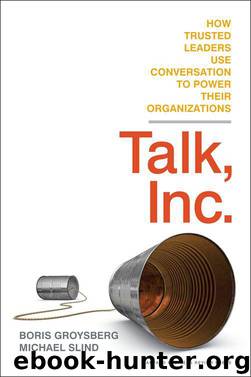Talk, Inc.: How Trusted Leaders Use Conversation to Power their Organizations by Boris Groysberg & Michael Slind

Author:Boris Groysberg & Michael Slind [Groysberg, Boris]
Language: eng
Format: mobi
ISBN: 9781422173336
Publisher: Harvard Business School Press
Published: 2012-05-28T14:00:00+00:00
Developing Content
The job of finding, organizing, and packaging company information has long been precisely that—a job, a specialized endeavor undertaken by professionals. Typically working out of a corporate communication department, those professionals often boast degrees in journalism or communication studies; many of them have experience as reporters, editors, and producers at mainstream media outlets. Hiring them to create the content that other employees consume is, from a traditional standpoint, a perfectly sensible division of labor. Yet more and more leaders are calling upon the amateurs in their midst to help generate the material that sustains organizational communication. “I just don’t have enough staff within the PR department to cover everything that I need to have covered,” Larry Solomon says. “And I have a lot of great employees who want to help who are good writers. They’re right there on the front lines. Why not tap into these employee citizen-journalists to provide content for our intranet portal?” Solomon and his colleagues at AT&T, as we pointed out earlier, have sought to model the company’s intranet site on the consumer-facing sites of major media brands. “The only way to do that,” he says, “is to have relevant, fresh content all day long.” Today, big-time news organizations often feed their content stream by inviting audience members to send in story ideas and even full-fledged stories. (CNN, for example, does so through its iReport feature.) And there’s no reason, Solomon argues, why AT&T and other companies shouldn’t follow suit.
By encouraging ordinary employees to become producers as well as consumers of information about an organization and its activities—to become, as Solomon suggests, internal amateur journalists—leaders broaden the range of content available for use within that organization. They also, at a more profound level, transform the process of creating and delivering such information. Even in cases where employee-generated content assumes a fairly standard form, the fact that employees are providing it makes that effort inherently conversational. Here, then, is a sampling of how employees are providing content in areas of organizational communication that were once the sole bailiwick either of top executives or of designated professional communicators.
Download
This site does not store any files on its server. We only index and link to content provided by other sites. Please contact the content providers to delete copyright contents if any and email us, we'll remove relevant links or contents immediately.
Bad Blood by John Carreyrou(6275)
Rich Dad Poor Dad by Robert T. Kiyosaki(6175)
Principles: Life and Work by Ray Dalio(5961)
Playing to Win_ How Strategy Really Works by A.G. Lafley & Roger L. Martin(5500)
Management Strategies for the Cloud Revolution: How Cloud Computing Is Transforming Business and Why You Can't Afford to Be Left Behind by Charles Babcock(4438)
The Confidence Code by Katty Kay(4038)
Thinking in Bets by Annie Duke(3996)
American Kingpin by Nick Bilton(3507)
Delivering Happiness by Tony Hsieh(3281)
Project Animal Farm: An Accidental Journey into the Secret World of Farming and the Truth About Our Food by Sonia Faruqi(3018)
The Power of Habit by Charles Duhigg(2966)
Brotopia by Emily Chang(2896)
Mastering Bitcoin: Programming the Open Blockchain by Andreas M. Antonopoulos(2891)
The Tyranny of Metrics by Jerry Z. Muller(2846)
I Live in the Future & Here's How It Works by Nick Bilton(2844)
The Marketing Plan Handbook: Develop Big-Picture Marketing Plans for Pennies on the Dollar by Robert W. Bly(2793)
The Content Trap by Bharat Anand(2778)
Building a StoryBrand by Donald Miller(2754)
Applied Empathy by Michael Ventura(2750)
